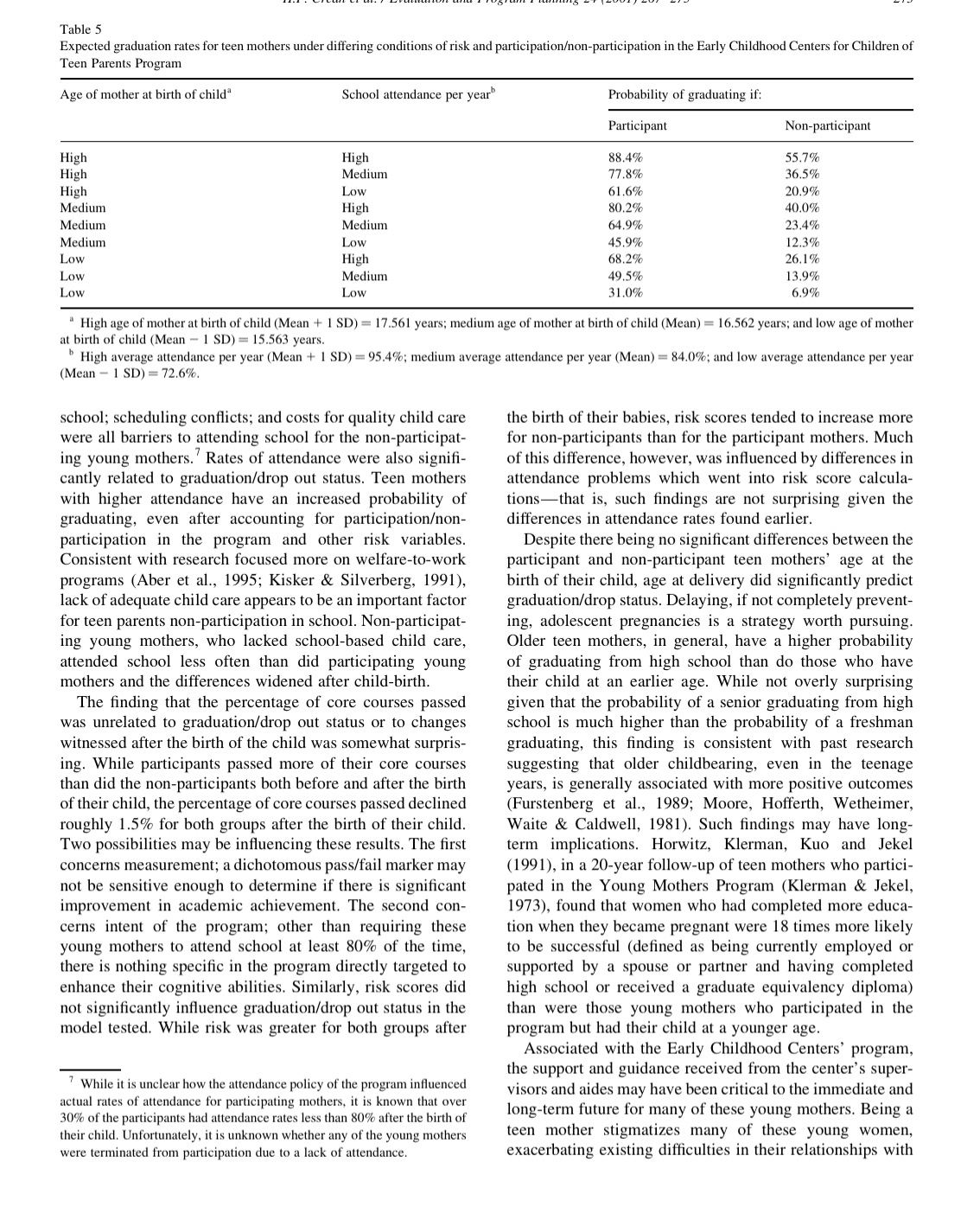Explain the results of Table 5
Table 5 B ORLILE ST e ser eer P Expected graduation rates for teen mothers under differing conditions of risk and participationon-participation in the Early Childhood Centers for Children of Teen Parents Program Age of mother at birth of child\" School attendance per year\" Probability of graduating if: Participant Non-participant High High 88.4% 55.7% High Medium 77.8% 36.5% High Low 61.6% 20.9% Medium High 80.2% 40.0% Medium Medium 64,9% 23.4% Medium Low 45.9% 12.3% Low High 68.2% 26.1% Low Medium 49.5% 13.9% Low Low 31.0% 6.9% * High age of mother at birth of child (Mean + 1 SD) = 17.561 years; medium age of mother at birth of child (Mean) = 16,562 years; and low age of mother at birth of child (Mean 1 SD}) = 15.563 years. " High average attendance per year (Mean + | SD) = 95.4%; medium average attendance per year (Mean) = 84,0%; and low average attendance per year (Mean 1 SD) = 72.6%. school; scheduling conflicts; and costs for quality child care were all barriers to attending school for the non-participat- ing young mothers.\" Rates of attendance were also signifi- cantly related to graduation/drop out status. Teen mothers with higher attendance have an increased probability of graduating, even after accounting for participationon- participation in the program and other risk variables. Consistent with research focused more on welfare-to-work programs (Aber et al., 1995; Kisker & Silverberg, 1991), lack of adequate child care appears to be an important factor for teen parents non-participation in school. Non-participat- ing young mothers, who lacked school-based child care, attended school less often than did participating young mothers and the differences widened after child-birth. The finding that the percentage of core courses passed was unrelated to graduation/drop out status or to changes witnessed after the birth of the child was somewhat surpris- ing. While participants passed more of their core courses than did the non-participants both before and after the birth of their child, the percentage of core courses passed declined roughly 1.5% for both groups after the birth of their child. Two possibilities may be influencing these results. The first concerns measurement; a dichotomous pass/fail marker may not be sensitive enough to determine if there is significant improvement in academic achievement. The second con- cerns intent of the program; other than requiring these young mothers to attend school at least 80% of the time, there is nothing specific in the program directly targeted to enhance their cognitive abilities, Similarly, risk scores did not significantly influence graduation/drop out status in the model tested. While risk was greater for both groups after " While it is unclear how the attendance policy of the program influenced actual rates of attendance for participating mothers, it is known that over 30% of the participants had attendance rates less than 80% after the birth of their child. Unfortunately, it is unknown whether any of the young mothers were terminated from participation due to a lack of attendance. the birth of their babies, risk scores tended to increase more for non-participants than for the participant mothers. Much of this difference, however, was influenced by differences in attendance problems which went into risk score calcula- tionsthat is, such findings are not surprising given the differences in attendance rates found earlier. Despite there being no significant differences between the participant and non-participant teen mothers' age at the birth of their child, age at delivery did significantly predict graduation/drop status. Delaying, if not completely prevent- ing, adolescent pregnancies is a strategy worth pursuing. Older teen mothers, in general, have a higher probability of graduating from high school than do those who have their child at an earlier age. While not overly surprising given that the probability of a senior graduating from high school is much higher than the probability of a freshman graduating, this finding is consistent with past research suggesting that older childbearing, even in the teenage years, is generally associated with more positive outcomes (Furstenberg et al., 1989; Moore, Hofferth, Wetheimer, Waite & Caldwell, 1981). Such findings may have long- term implications. Horwitz, Klerman, Kuo and Jekel (1991), in a 20-year follow-up of teen mothers who partici- pated in the Young Mothers Program (Klerman & Jekel, 1973), found that women who had completed more educa- tion when they became pregnant were 18 times more likely to be successful (defined as being currently employed or supported by a spouse or partner and having completed high school or received a graduate equivalency diploma) than were those young mothers who participated in the program but had their child at a younger age. Associated with the Early Childhood Centers' program, the support and guidance received from the center's super- visors and aides may have been critical to the immediate and long-term future for many of these young mothers. Being a teen mother stigmatizes many of these young women, exacerbating existing difficulties in their relationships with







